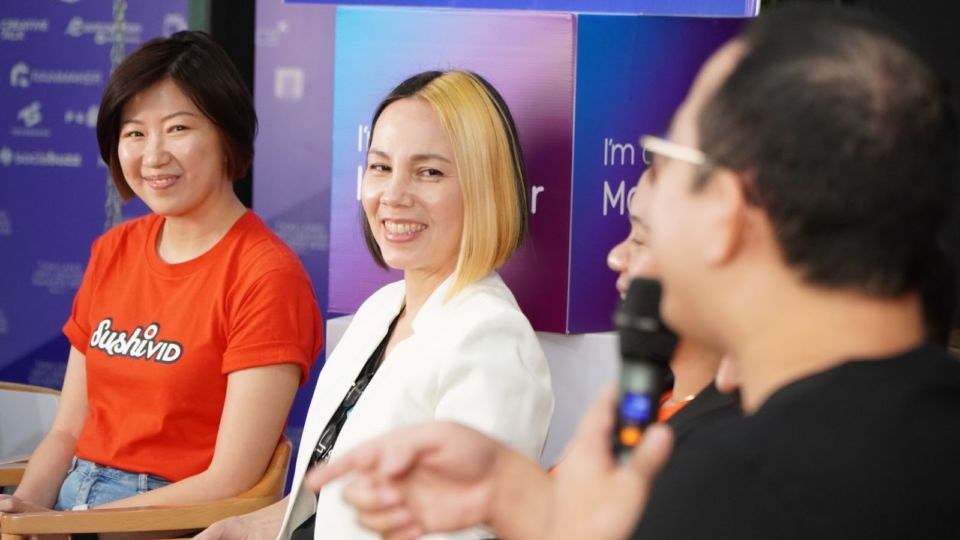We’ve all been there: scrolling through our favorite TikToker’s clips or binge-watching our comfort influencer’s review videos of her skincare favorites for October. Suddenly, that Japanese mouthwash she’s using is on our shopping list.
Why does a TikTok or Instagram reel of a blogger talking about the lipstick to buy for this holiday shopping season tingle your “Add to Cart” button more than a highway billboard? The experts at Tellscore, a platform that pairs brands with influencers in specific fields, as well as other influencer marketing brands across Southeast Asia and Australia, sat down at the “The Shaping of Asia Pacific Influencer Economy” panel at the Thailand Influencer Awards 2022 to tell us why.
On the panel was Suvita Charanwong, CEO and co-founder of Tellscore Thailand, Yuhwen Foong, CEO and founder of Malaysia’s SushiVid, Ace Gapuz, CEO of the Philippines’ Blogapalooza, Rade Tampubolon, CEO and co-founder of Indonesia’s SocialBuzz, Ajeng Febrianti, Community Manager at Tellscore Indonesia, and Detch Singh, CEO and founder of Australia’s HypeTap. Talk about cross-cultural influencers!
Photo: Tellscore
Photo: Tellscore
What are the advantages of using influencer marketing, compared to other methods of marketing?
Rade from SocialBuzz: I used to work for a brand before social media was booming. Back then, how we marketed the brand was very one-way: we as a brand spoke to the customer. But social media influencers gave us a new way to talk to potential customers. Influencer marketing allows us to go very niche into segments, sub-segments, sub-sub segments of education, skincare, or fashion.
It’s not spray and pray any more. It’s like using a sniper. We can specifically target segments by working with influencers, rather than using billboards or TV.
Ajeng from Tellscore Indonesia: Influencers can build trust with people. People can know their face, their names, and even trace back to see what they did six years ago. People build this relationship and relevance with them.
Ace from Blogapalooza: In the Philippine context, I come from a country that is very celebrity-crazy. Online, we see that these people hold so much power over people in terms of molding their opinions, shaping preferences, even encouraging people to believe in things.
On the political side, the Philippines has just gone through our recent national elections where we elected the current president. Influencers were one of the most powerful media that they used.
Q: Tell us about the strategy you use to pick the right influencer for a brand.
Detch from HypeTap: For us, we have a very clear three-step approach in picking influencers. The first is contextual relevance: is their content relevant to the brand? Second is audience data: is their audience the kind we’re trying to reach from a demographic perspective? Third is brand safety. If we’re talking about Coca Cola, then we have to make sure they haven’t been talking about Pepsi last week.
Detch Singh, CEO and founder of Australia’s HypeTap. Photo: Tellscore
Q: What are the challenges for influencer marketing that you see in the future?
Wen from SushiVid: There are challenges every year since we started a business. We started with YouTube in mind, then suddenly brands wanted Instagram, then Instagram stories, Instagram reels. Then TikTok came out of nowhere, and now there’s TikTok Shop and Taobao livestreams. Every single point of my journey has changed in the last seven years.
Ace from Blogapalooza: We’ve had clients and partners thinking of influencer marketing as the magic pill. They get a lot of numbers that they never got before, such as videos getting 5 or 10 million views. They expect the influencer to deliver everything for them and increase sales, but these magic moments are only one in a million, and influencers are only a slice of the pie.
Q: How are markets in each country different from influencer marketing in Thailand? What about the possibility of cross-border influencer marketing in the next few years?
Suvita from Tellscore Thailand: Brands that were born during the pandemic are digitized. For the past 12 months we see companies have apps as a core product, such as education tech and health tech. For example, if an education tech is teaching English in Malaysia, it’s very easy to penetrate the Thai market.
Ace from Blogapalooza: There are things unique to each country, and brands want to be appropriated to whichever market. The Philippines are a very Facebook-heavy country, so we see that Communities in Facebook are working very well for our brand campaigns, so much so that a lot of the brand campaigns we’ve been running always have a community aspect in the mix.
Meissie Kemala, rising star TikToker, Indonesia. Photo: Tellscore
Ace Gapuz, CEO of the Philippines’ Blogapalooza. Photo: Tellscore
Q: What are the price factors in each country?
Ace from Blogapalooza: Pricing is relative; different influencers price differently. If it’s a very saturated niche, usually you have a lot of bargaining power. But if it’s a very specific niche, such as ophthalmology or palliative care, even if their follower counts are not that high, then they can usually command higher prices.
Q: How do agencies or influencers deal with the problem of people skipping the sponsored ad section of content?
Wen from SushiVid: Every content has to be really creative about how they tie in the brand. I’ve seen some American ones where the influencer says that they need this to pay the bills, and then they talk for 30 seconds, and the audience who has been supporting them is okay with watching the ad. You have to be creative, because once your audience smells it’s an ad, they switch off.
Ajeng Febrianti, Community Manager at Tellscore Indonesia. Photo: Tellscore
Yuhwen Foong, CEO and founder of Malaysia’s SushiVid. Photo: Tellscore
Q: What makes a good influencer?
Ajeng from Tellscore Indonesia: From the point of view of the agency, a good influencer is someone with awareness of their position, and they don’t overclaim when they promote services or products. Insightful influencers can also help the agency with data about their audience, so we can have a better- planned campaign for the client.
Q: Why should people believe in influencers?
Ace from Blogapalooza: Influencers can say, “this was my experience, this could be your experience too,” which more traditional forms of media wouldn’t be able to provide. A TV could say “This is nice,” and you could take that at face value. An influencer, however, would tell you the story of why this is good, why I like it, why it’s personal for me. It’s that personal touch that makes influencers believable.
Detch from HypeTap: If you go to a hairdresser and ask, “Are you good at cutting hair?” of course they would say yes. But if you go to another customer and ask them, that’s a different level of trust you have in a third party. And it’s that third party trust that’s so powerful, which these creators have been building up for so many years.
Rade Tampubolon, CEO and co-founder of Indonesia’s SocialBuzz. Photo: Tellscore
Q: What is the most popular social media platform in your country? What kind of content is most powerful for use in influencer marketing in each country?
Suvita from Tellscore Thailand: We’re seeing the perfect type of content for the social media platform. For instance, Thailand is a very Facebook-heavy country, used by not just Gen X and up, but a lot of businesses.
YouTube can deliver tremendous amounts of high quality long-form content. The audience there is considered to be of a different quality, since they pay attention there longer, and this can result in better conversion rates.
I would say we take into account all of the channels. Even blogs are coming back, because a lot of influencers are hesitating with the uncertainty of social media that reduces their organic reach, and they also need SEOs, so they create their own websites.
Photo: Tellscore
Q: What is the future of influencer marketing in the next three to five years? Are virtual influencers in the picture?
Suvita from Tellscore Thailand: In a digital economy, when you ask three years, five years, it’s a taboo question (laughs). We will be wrong immediately, since it changes that fast. It’s definitely a flourishing sector, and we have the creators to thank, because they have the trust of the followers. We’re here to make sure the community stays safe, and brands should chip into that safety. Growth is going to happen if we keep nurturing it.
In Thailand alone we have 13 native virtual influencers. That’s a huge number for the 60-70 million population that we have.
Ace from Blogapalooza: We’re seeing that creators are becoming their own media companies in the next few years. They’re hiring their own teams and building their own studios.
As long as people are telling stories, influencer marketing is going to grow. Storytelling has been here for ages since civilization came about. Storytelling at its core will make this industry something that will live for a very long time.
Editor’s Note: Responses have been edited for length and clarity.





